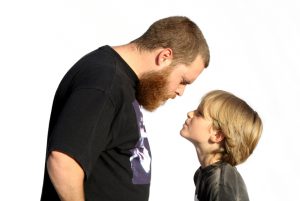The mad monster made me do it!
 When we are little, our needs get expressed through our strong emotions. A baby doesn’t have the capacity to get food when hungry, a blanket when cold or a change of a wet diaper. Instead, they fuss! They muster the voice of the “mad monster” to get the attention they need, whaling and whimpering. This gets someone to come and attend to his or her needs. How loud it is and how long it lasts depends on the baby and on how the caretaker responds to the signaling.
When we are little, our needs get expressed through our strong emotions. A baby doesn’t have the capacity to get food when hungry, a blanket when cold or a change of a wet diaper. Instead, they fuss! They muster the voice of the “mad monster” to get the attention they need, whaling and whimpering. This gets someone to come and attend to his or her needs. How loud it is and how long it lasts depends on the baby and on how the caretaker responds to the signaling.
As the baby grows into a toddler, gaining mobility with crawling then walking, they begin to act on their on their own interests. When possible for them to achieve their own goal, fussing may go down. But, when confronted with a “no,” the bodily expression of overwhelming feelings can show up. Inside, all the chemicals that fuel the survival need that formerly got attention when the infant was cold or hungry may fire inside when told “no.” Heart rate, breathing and muscles tense as if this is a life and death matter. Behaviorally, yelling, arguing, biting, kicking, hitting, crying, throwing may show up.
The need to be heard and get help is life long, however the full body response that worked so well as an infant and young child needs to evolve. As the world of opportunities and experiences expands, needs and desires get more complex. Emotions that get stirred need to be handled differently. “It’s not fair,” is a common refrain of childhood as an expression of disappointment. Sometimes the “it’s not fair” grows and grows, getting bigger and bigger, feeding the mad monster as an injustice and what might feel like righteous indignation. In the child’s mind, this upset is justified because, after all, “it isn’t fair!” They don’t have the power to change the world as they had in the past, getting others to meet their needs and respond to their distress. The thought of “it’s not fair” “I never win” “You never let me…” all feed the mad monster. With each of these thoughts, the mad monster gets angrier and the reactions get louder, bigger, stronger, hotter and more aggressive. Sometimes the only way the child can think about the upset is to blame the mad monster, “I did it because I was mad!”
So, to tame the mad monster we have to help our kids to not feed it! Because it is a full body response, there are two ways to work with the mad monster. One way is to calm the body, take the fire out of its belly by reversing the effect of the survival chemicals, because after all, “Its not fair” is not a threat to survival. Calming ourselves can model for our children how not to feed the mad monster. Instead of yelling or punishing, we need to first take a moment to focus on slowing our breathing down. This step can take the fight out of our mad monster and in turn help us guide our children to the do the same; take a moment to take a breath before anything else happens.
The second way is to hear the message so fire and fury can be converted to communication. The goal is to help our children communicate their needs, concerns and emotions effectively so they can understand their emotional selves and learn how to navigate in the world of others. We can take a moment to consider how to translate “It’s not fair” to “I don’t like it!” “It’s hard” or “I’m disappointed.” It is really easy for parents to get wrapped up into trying to “make things fair,” explain why things are “not fair” or dismiss your child’s upset because “life isn’t fair.” While we hate to see our kids in distress, none of these responses help your child learn how to stop feeding the mad monster. To teach your child to stop feeding the mad monster a parent can help them to recognize that it is disappointment and sadness given the facts are not fitting with their wishes. Learning to accept what you can’t change is an important life skill.
The mad monster is something we all have to face. As we support the growth and development of our children, this vital life force needs to shift from the unbridled needs to get harnessed and converted into effective communication and action. It is understandable that “It’s not fair” gets the monster to rear it’s ugly head. Continuing to engage in arguing or responding to the statements as if logic is going to tackle and wrestle the mad monster to the ground only feeds it. Instead, consider the two ways to tame the monster – decreasing its energy by reversing the breathing and taking away it’s food!
Tags: discipline, parenting, parenting advice, parenting skills, parenting tips, tantrum, temper tantrums








Leave a Reply